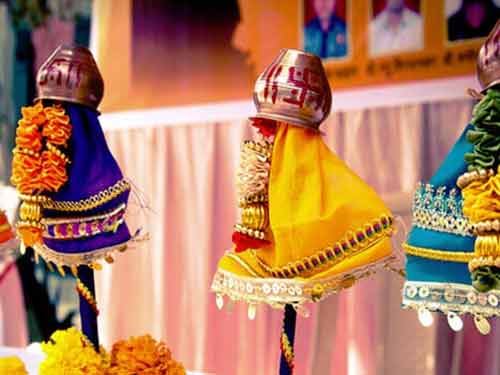Gudi Padwa is the Hindu New Year in Marathi culture as per traditional lunar calendar followed in Maharashtra . Gudi Padwa 2025 date is March 30, 2025. It is observed mainly in Maharashtra, Goa and parts of Karnataka. As per traditional Marathi calendar, this New Year is the Vishvasu Nama Samvatsara and the Shri Shalivahan Shaka 1947 begins on the day. The first month in the Marathi calendar is Chaitra and Gudi Padwa is observed on Chaitra 1 or the first day of Chaitra. The most important event on the day is the hoisting of the Gudhi (victory flags) in front of the homes.
Vishvasu Nama Samvatsara begins from March 30, 2025.
Shalivahana Saka year - 1947 begins on March 30, 2025.
Ugadi (Kannada and Telugu New Year) will be observed on March 30, 2025.
Vikram Samvat 2082 begins in North India on the day.
Vikram Samvat 2082 begins in North India on the day.
Why is Gudi Padwa Observed?
There numerous reasons for observing Gudi Padwa - the most important legends are the defeat of Shakas by Shalivahan and some people observe it to commemorate the victories of Chatrapati Shivaji Maharaj.
As per Brahma Purana, Lord Brahma created the universe in the morning of the first day of Chaitra month.
Some say it is hoisted to the celebrate Bhagavan Sri Rama’s return to Ayodhya after killing Ravana.
Gudi Padwa Puja
In order to protect one's family from difficulties and calamities, the head of the family performs puja on the Gudi Padwa day. It is dedicated to Lord Ganesha, Lakshmi, Saraswati and the family deity. The puja is also performed for a prosperous year.
Gudi Hoisting - Lord Brahma’s flag (Brahmadhvaj)
The most important event on the day is the hoisting of flags on a bamboo staff. The flag hoisted on Maharashtrian New Year is made of green or yellow colored silk cloth. A bright garlanded goblet is hung on top of the flag pole. Neem leaves, mango leaves, garland of red flowers and gaohi (sweet) are hung on the Gudhi. Rangoli is drawn near the Gudi or in front of the house.
Gudi Padwa Offerings
Offering made of neem leaves and neem flowers and jaggery is distributed on the day. The offering consists of neem leaves and neem flowers, soaked dal, cumin seeds, honey or jaggery and asafetida. The offering symbolically indicates that life is filled with joy and sorrow.
Auspicious Day In A Year
Gudi Padva is one of the most auspicious days in the Marathi Hindu Calendar and is considered ideal for starting new ventures and investment. It is believed that every moment on the Gudi Padwa day is auspicious. The day also heralds the arrival of the spring season. Several auspicious events take place on this day. It is believed that every moment on this day is auspicious.
Puran Poli
Apart from this, Maharashtrian households prepare the delicious ‘puran poli’ and distribute it to neighbors, relatives and friends. A sweet dish prepared using jaggery and wheat flour.
Farmers make it a point to plough the field on the Gudi Padva day and they believe it will help in having a good harvest in the ensuing agricultural season.
When Gudi Padwa is celebrated by Marathi people, the Kannada and Telugu speaking people celebrate Ugadi.
Why is Gudi or Flag raised on the New Year Day in Maharashtra?
One of the most important events on Gudi Padwa is the raising Gudhi. Gudhi, or Gudi, is a special kind of flag raised by Maharashtrians outside the house on the Hindu New Year Day – the first day of Chaitra month (March – April). Gudhi is also known as Flag of Brahma – Brahmadhwaj or Brahma Dhwaj.
Raising of the Gudhi in front of one’s house symbolizes hope, happiness, joy, glory and celebration of victory.
The Gudhi is made of 5 to 10 feet long bamboo or any other wooden stick. A piece of silk or cotton cloth is tied at one end of the stick like a flag. A silver or steel or brass pot is placed on top of the Gudhi. A garland of flowers is placed on the top. In some regions neem leaves and sugarcanes are placed around the pot.
There are numerous legends associated with hoisting of the Gudhi. Some believe it is hoisted to the celebrate Lord Ram’s return to Ayodhya after annihilating Ravana and other demons. Some Maharashtrians hoist it to commemorate the numerous victories achieved by Chatrapati Shivaji Maharaj.
Symbolism in Gudi Flag Raised on Gudi Padwa
Symbolically, Gudi is asking us to empty our ego – take an inverted look within, hold yourself up to the vast sky of divinity and may your soul remain outdoors, away from the trappings of this world.
Another symbolism suggests that the neem leaves remind us to forget the bitter memories of the year while the gaathis that are made from jaggery remind us that sweet memories are to be cherished for years ahead. The piece of cloth that is used shows that the family is happy, peaceful and prospering. In Hindu mythology, copper is considered very auspicious, so it is used as an integral element in the Gudi.
Related
